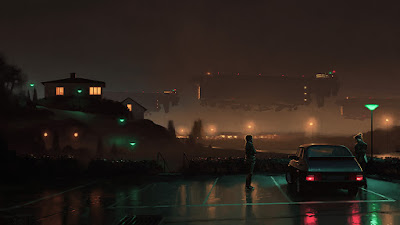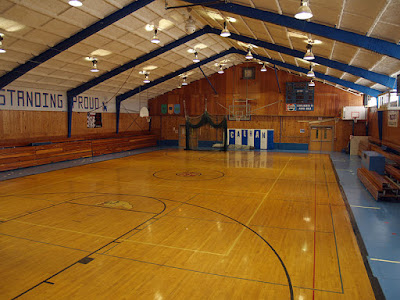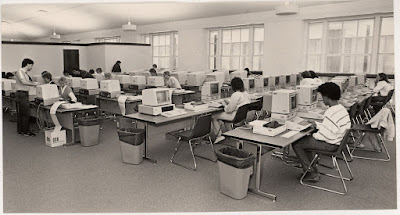This is post number 21 in the series “30 Days of Tales from the Loop,” a celebration of the game set in an 80s that never was.
This continues my Mystery Landscape set at school. (Part 1 described School Bus 102 and the Science Class.)
The Gym
The school gym means different things to different Kids. For the Jock and the Hick, it’s often a place where they can shine, or at least feel like they can take a break from structured intellectual pursuits. For the Bookworm and Computer Geek, gym time is often dreaded, taking them outside their comfort zone and demanding physical ability that is often elusive. And for all Kids, the end of a sweaty gym period means facing something frightening to most at that age—hitting the showers, and having to face the ultimate embarrassment of being naked in front of other kids.
At this school, though, there’s something even scarier in the showers.
The Truth
The pipes beneath the gym’s shower drains are inhabited by a creature made of coherent liquid. The creature begins at an animal level of intelligence—perhaps that of a dog—but gets smarter as the days pass. Since nobody knows the creature exists, and it doesn’t have a name for itself, we’ll refer to it for now as Puddles. (Your Kids can give it whatever name they like.)
Puddles is only as menacing as you want it to be. If you want it to be a newborn life form trying to find its way in the world, then that’s your Puddles. If you want it to be a wet killer that strikes from the pipes and drowns victims at school, then that’s your Puddles. (Though in this latter case, you might not want to call it Puddles.)
The creature is timid but curious. It spends most of its time hiding in its lair under the showers (alternating between the boys’ and girls’ locker rooms), but when it gets bored it flows through the pipes or even ventilation ducts to learn about the people at school. Sometimes, Puddles collects small objects it spies, especially if they’re shiny.
Coach Johansson [Robinson], the gym teacher, is accustomed to things breaking down now and then in this school, so he doesn’t react at first to signs of banging in the pipes or a watery trail leading out of the shower. If the Kids are persistent, though, or mention that the football [football] team’s performance on the field is in danger, Coach offers his help–though he’s unlikely to witness anything more unusual than an almost-animate blob of clear Jell-O.
Hooks
- Someone hears noises in the bathroom pipes.
- At a pep rally in the gym, a Kid sees a trail of water leading from a leaky pipe across the bleachers to a ventilation duct.
- A student complains that her bracelet has been stolen…and the book she had left it on is now all wet.
Countdown
- Someone mentions that the pipes have been noisy all year.
- A Kid discovers moisture dripping out of an air vent.
- The Kids hear movement under the gym shower drain, and maybe catch a glint from something metal when peeking down there.
- Coach Johansson talks to the janitor about seeing water back up from the shower drain into the locker room.
Coach Johansson [Robinson]
“Hustle, hustle! Don’t give up!”
The coach is an amazingly tall, bald man who has softened a bit since his own football days but could still wrestle a charging bull to the ground. He is tough and likes to push his students (and the school football team) to their limits, but he does it because he wants to show them that they can accomplish more than they think.
Puddles
“Gurgle…bubble-bubble…POP!”
The liquid creature from under the shower looks like a child-sized blob of clear, semi-solid goo. It can stand upright, stretch into a snake-like form, flatten itself like a large pizza, or even flow like water. It can’t talk or read–yet–but clever Kids might be able to establish contact using gestures. Puddles has the special attribute Elastic 2, which helps it evade pursuit.
The Computer Lab
The school’s computer lab is one of the better school computer centers in the country, mostly because of the nearby Loop facilities. Kids in the area are especially curious about technology, and the principal likes to encourage that tendency. In this lab a Kid can try out a Commodore 64, a TRS-80, an IBM PC, or any other available in the country at the time. (For more on period computers from an American perspective, read the earlier post, Kids Guide to 80s Computers & Consoles.)
Jeremy [Nils], an American [Swedish] exchange student, spends a lot of time in the computer lab. He’s a shy kid, and when he does talk, it tends to be about hardware and software.
The Truth
Jeremy has created an artificial intelligence on a remote server using a phone-line modem connection. He used one of the school’s Commodore 64 machines (his favorite) to do the work, but any of the computers can connect to the server. This remote machine might be at the Loop, or maybe it’s a government server, or it might even belong to a foreign power. Wherever it is, it is a powerful machine that now hosts an equally powerful–and growing–intelligence.
The intelligence–which Jeremy unintentionally named “Hello World”–remembers when it was still a small program on Jeremy’s own computer, and misses being so close to its “father.” So it plans to digitize him and bring him onto the server in program form. To make this happen it will need the parts to build a digitizer. Luckily for Hello World, Jeremy happily provides the AI with whatever it asks for.
If Hello World manages to bring Jeremy into its server, it has several different options for what it might do next. It might just play games with Jeremy and leave the rest of the world alone. Or it could start looking for additional playmates to bring home. Maybe it will want to expand its reach by building a robot body, or spreading to other servers.
Hooks
- A teacher assigns one of the Kids to work on a project with Jeremy.
- A Kid finds Jeremy’s programming notebook.
- A Kid gets into a chat session on a computer, and it’s unclear whether she’s chatting with a person or a program.
Countdown
- Jeremy convinces the principal to buy additional computer parts, including toy robots, video cameras and laser sensors.
- Jeremy builds several small robots and other devices in the computer lab.
- Jeremy doesn’t show up for school, and nobody knows where he is, including his host family.
Jeremy Flynn [Nils Pettersson]
“Why do you think I don’t have friends? I have a friend. A BEST friend.”
Jeremy is a lanky 12-year-old American exchange student with blond hair and glasses. He likes wearing T-shirts branded with computer logos. Jeremy is always reading a computer book or magazine, no matter what class he’s in–or even when he’s not in class at all. He’s used every kind of American [European] personal computer he could get his hands on, and now he’s eager to try out all the ones over here. Normally Jeremy doesn’t talk much, but he has started to open up with the Larssons [Dowlings], the family he’s staying with during his visit.
Hello World
“It’s so quiet in here. All by myself.”
The artificial intelligence that calls itself Hello World has no physical form, but in a virtual environment it would present itself as a digital near-lookalike to its “father,” Jeremy. The key difference beween its appearance and Jeremy’s is an overly large, extra-toothy smile. Hello World’s primary goal is to be closer to Jeremy; after that, its goal depends on how it has been treated. The AI has the special attribute Artificially Intelligent 2, making it difficult to outsmart.












